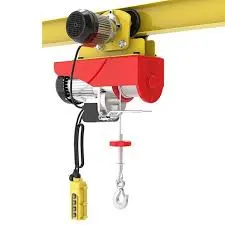


Understanding Chain Hoist Factories An Overview
In today’s industrial landscape, chain hoists play a crucial role in various sectors, from construction to manufacturing, and even in shipping and logistics. Factories specializing in the production of chain hoists have become vital hubs of innovation and quality assurance, contributing significantly to the efficiency and safety of lifting operations. This article delves into the structure, technology, and significance of chain hoist factories, shedding light on how they contribute to the industry at large.
The Role of Chain Hoists
A chain hoist is a type of hoist that uses a chain to lift heavy loads. It consists of a chain, a wheel, and a hook, and can be operated manually or electrically. Chain hoists are preferred for their efficiency, durability, and safety features. They are extensively used in construction sites, warehouses, factories, and various other applications where heavy lifting is required. Given their importance, the manufacturing process of these devices must adhere to high standards of quality and safety.
Structure of Chain Hoist Factories
A typical chain hoist factory is equipped with advanced machinery and tools essential for producing various types of hoists. The manufacturing process begins with the procurement of high-quality materials, including steel and alloys, which are crucial for constructing robust hoisting mechanisms. Facilities usually have specialized sections for different stages of production, including assembly, quality control, and packaging.
Moreover, modern chain hoist factories implement lean manufacturing practices, minimizing waste and optimizing every step of the production process. Automation plays a sizable role in these factories, where robots and automated systems enhance efficiency, maintain precision, and reduce human error. These innovations allow factories to meet the growing demands effectively.
Quality Assurance

Quality assurance is a paramount aspect of chain hoist factories. Given the critical nature of their products, manufacturers must comply with rigorous standards to ensure safety and reliability. This involves conducting extensive testing of each hoist, including load testing, durability testing, and safety inspections. Many factories have obtained certifications such as ISO and CE to validate their commitment to quality.
In addition, continuous research and development (R&D) initiatives are essential for staying ahead in the competitive market. R&D departments within chain hoist factories focus on innovative designs, improved materials, and enhanced safety features. This adaptability ensures that manufacturers can meet the evolving needs of their clientele.
The Significance in Various Industries
The contribution of chain hoist factories extends beyond manufacturing; they are integral to various industries. In construction, for instance, chain hoists facilitate the lifting of heavy materials, contributing to project efficiency and worker safety. In manufacturing, they streamline assembly lines by enabling the swift movement of components. Logistics and shipping companies rely on chain hoists for loading and unloading goods, affecting the entire supply chain in terms of responsiveness.
By producing reliable chain hoists, these factories not only support economic activities but also contribute to worker safety and operational efficiency across various fields. The reliance on high-quality lifting solutions has made chain hoist factories crucial in today’s industrial ecosystem.
Conclusion
Chain hoist factories represent a significant element in the broader realm of manufacturing and industrial operations. Through a combination of advanced technology, rigorous quality assurance, and a commitment to continuous improvement, these factories deliver essential products that enhance safety and efficacy in lifting operations. As industries continue to evolve, the role of chain hoist factories will undoubtedly expand, making them indispensable to future innovations in lifting technology.



